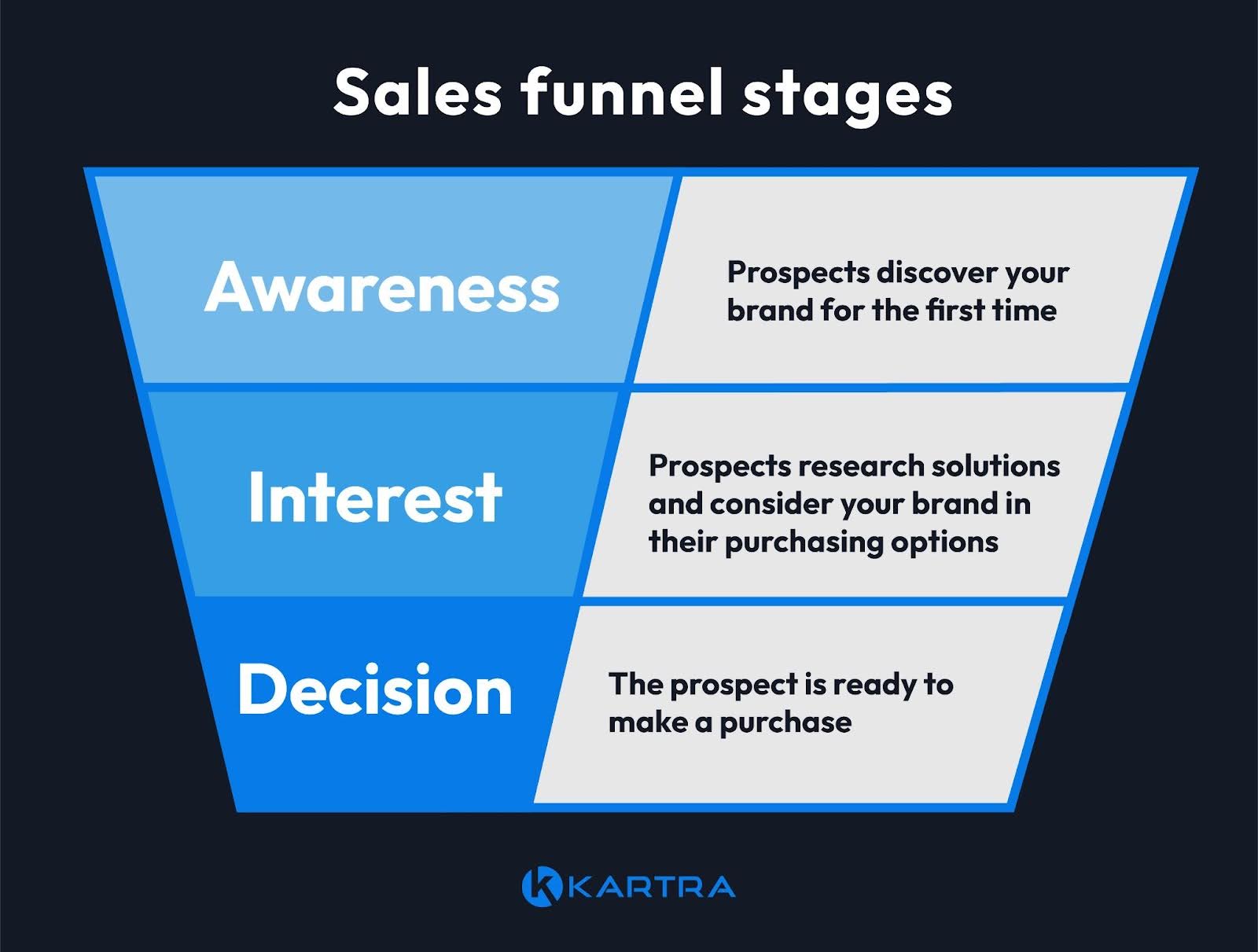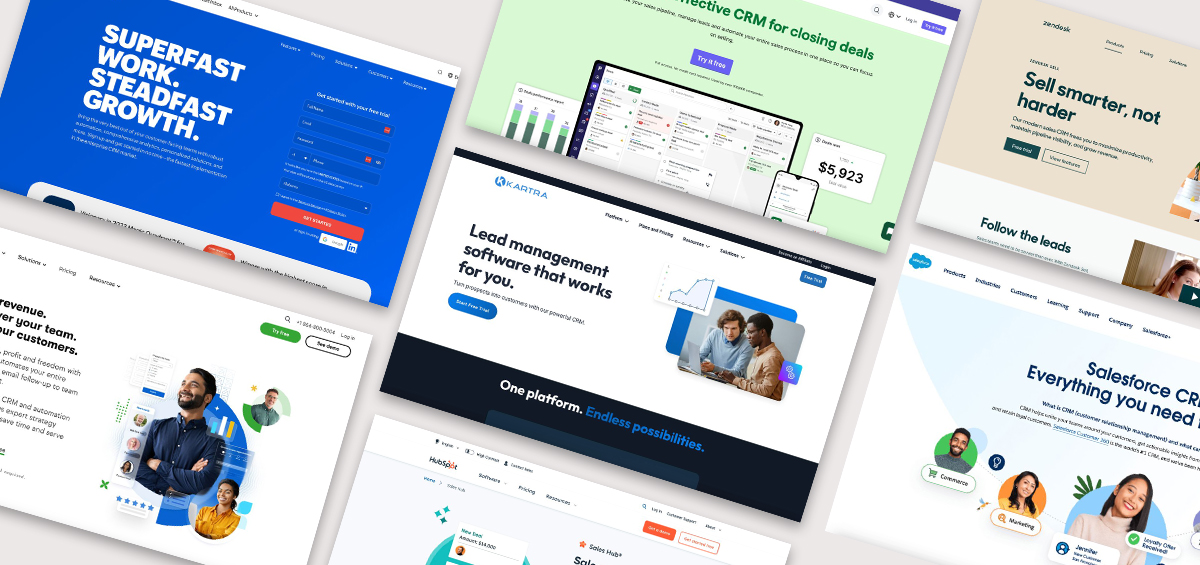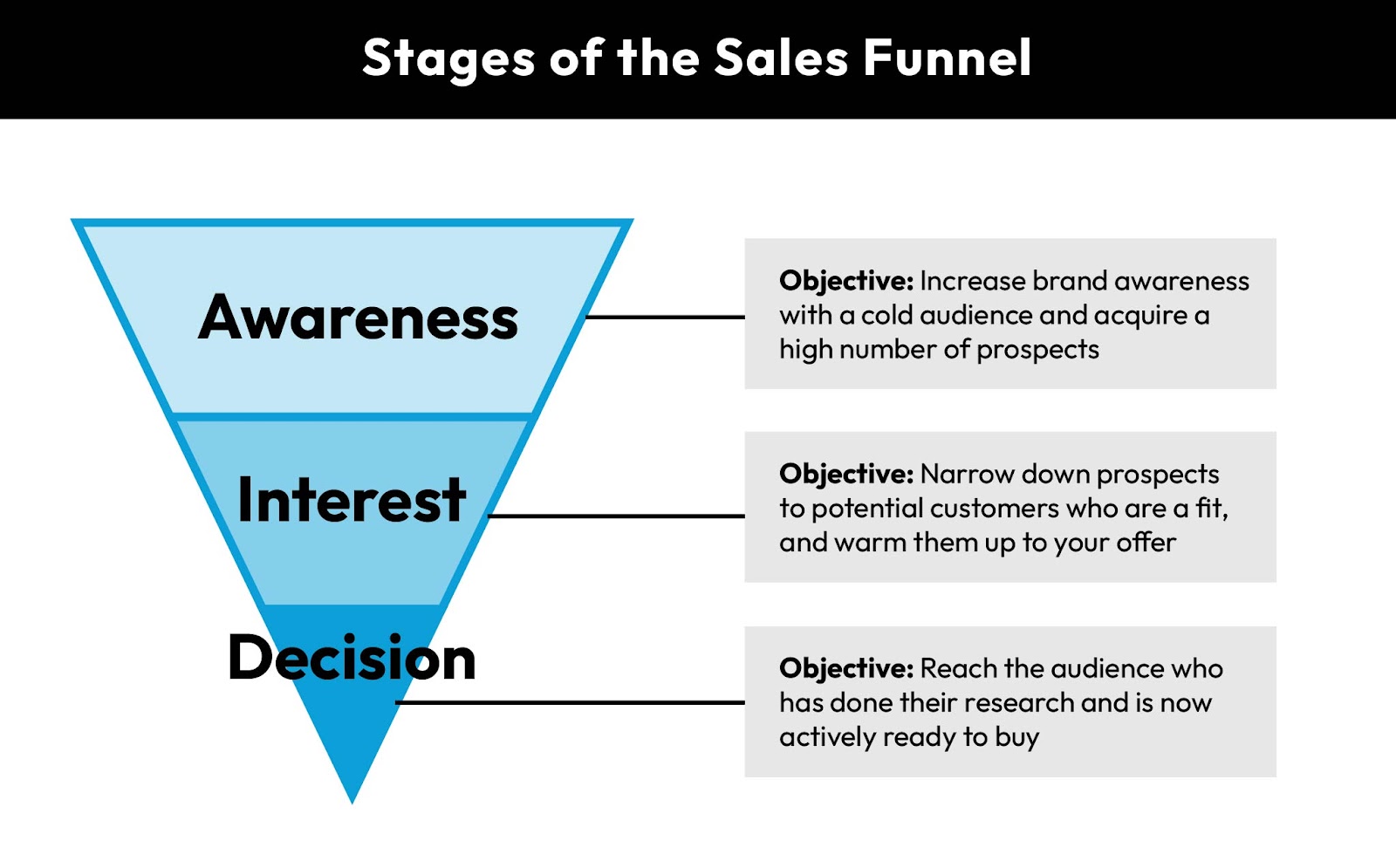While it may sound complex, a sales funnel is actually a simple idea. In short, a sales funnel is an intentional series of interactions brands use to engage potential customers and lead them toward a buying decision. Funnels are a key element of business growth. They nurture the customer relationship from the early stages of the sales process to deliver a great customer experience and increase customer retention.
If you’ve been counting on word-of-mouth or direct Google searches to find new clients, a strategic funnel may be the next step for you to begin nurturing prospects more intentionally.
While the concept is simple, sales funnels themselves can be complex systems that intentionally nurture prospects toward a purchase. Today, most sales funnels are digital. They combine marketing tactics like email marketing, social media advertising, and search engine optimization to create the customer journey.
Once you become familiar with how a sales funnel works you’ll be ready to take the next step and use our step-by-step guide to building your own!
Stages of the Sales Funnel

In every sales funnel, the customer travels along a sales pipeline through three main stages, each with its own unique objectives and strategies. The goal of the sales funnel is to move prospective customers from one stage to the next—they begin as unaware prospects and, with nurturing, become paying customers. At each stage, the customer becomes more and more likely to make a purchase.
Top of the Funnel: Awareness Stage
Marketing Objective in this stage: Increase brand awareness with a cold audience and acquire a high number of prospects.
In this first stage the goal is to make a new audience aware of your brand and its product or service. Reaching a top-of-funnel audience is done in various ways, but the most common methods are content marketing, Search Engine Optimization (SEO), and social media. Awareness is critical because an audience will never become customers unless they know you exist.
Middle of the Funnel: Interest Stage
Marketing Objective in this stage: Narrow down prospects to potential customers who are a fit for your product or service, and warm them up to your offer.
In the interest stage, the sales funnel targets a segment of your audience who is directly seeking a product to match their needs. They might be aware of your brand but they’re still researching the different options. Education is key to capturing this audience’s attention, so downloadable case studies, webinars, whitepapers, and free trials or other special offers are used to move them down the sales funnel. This phase is sometimes called the consideration phase.
At the interest stage, you already have a customer’s attention and probably their contact information, so advertising strategies like retargeting website visitors and email marketing campaigns play a major role.
Bottom of the Funnel: Decision Stage
Objective: Reach the audience who has done their research and is now actively ready to buy.
The final stage of the sales funnel is called the decision stage or action stage. The audience here is smaller than in other stages, but far more valuable. To help the customer commit to a purchase make sure information about pricing, terms, shipping times, and availability is easy to find.
The Basic Components of a Sales Funnel Strategy
Now that you understand the three stages of the sales funnel, let’s take a closer look at how an effective funnel strategy is crafted.
Clearly Defined Objectives
Before thinking about a strategy, define a set of highly specific goals for your sales funnel. Ultimately, the goal for any business is to gain paying customers, but not every sales funnel has that immediate objective. In order to measure the funnel’s effectiveness, it’s important to be clear about which key performance indicators (KPIs) you want to measure. What does success look like?
- For a course creator: to increase new subscribers or have previous students take additional courses
- For a realtor: to attract new home buyers or to reach home sellers
- For a SaaS company: to acquire more product demos and leads for your sales team to follow up, or to introduce a new product to the market and create an online buzz within your industry
A Detailed Buyer Persona
With the goals of your funnel in mind, identify the ideal buyer persona for targeting. Create a profile of your most likely and desirable customer. What qualities and characteristics do they have? What pain points do you solve for them? Begin the profile by outlining basic information, such as:
- Age
- Location
- Income Levels
- Job Titles
- Hobbies/Interests
- Desires/Fears
- Life Goals
This information will help you create a profile for a hypothetical individual who has the potential to become an excellent customer. Get super specific—visualizing your customers as a specific person can help you fine tune your marketing plans, tone of voice, and marketing materials. Your buyer persona for an inventory technology solution, for example, might be “Mark,” who works as a purchaser at a supermarket chain. He wants to reduce supply chain issues at the company he works for because he is hoping to get a promotion.
A Strategic Marketing Plan
Now that you’ve established clear goals and a target audience, the next step is to create a marketing strategy to cover all stages of the funnel. Keep in mind that your messaging will be different at each stage of the funnel, and the tactics you use might vary.
If your target audience is highly engaged on social media, you’ll need to create content and advertising campaigns for multiple social platforms. For a small brand competing with established industry leaders, promotional offers and direct email marketing will play a large factor. If your product is technical, then search engine optimization plays an important role. Taking the time to plan and map out the entire funnel before you start can save significant time and money.
Before you can start building out your funnel online, you’ll need the tools to make it happen:
- Creative Assets: From ads to social media content to PDF downloads, you’ll need a variety of creative assets to execute a campaign. Tools like Canva, Adobe Photoshop, and AI tools (artificial intelligence) are perfect for creating stunning original videos, product images, and graphics.
- Landing Page Software: Virtually all sales funnel traffic is sent to funnel-specific landing pages. While the homepage, shopping, or contact pages carry evergreen content, funnel landing pages contain offers and calls to action (CTAs) that are unique to the sales campaign. Driving campaign traffic to these landing pages allows you to accurately optimize the content, monitor metrics, and a/b test details to see what performs the best. Optimizing a funnel landing page is an ongoing process, so be sure to choose an easy-to-use page builder that has templates to get you started.
- Email Marketing: As new leads join your email list and enter the funnel, you need an email marketing platform with automation capabilities. These platforms allow you to create email campaigns that run on autopilot to nurture your new leads, moving them to the next stage of the funnel automatically based on their interactions with your marketing. Robust email software is probably the most important tool in your marketing arsenal.
- CRM: A CRM (customer relationship manager) is software that stores key information about your leads like names, email addresses and purchases. CRMs come with varying levels of complexity. If you’re just getting started, keep things simple with a tool that is designed primarily for automated lead management.
- Checkout Pages: Simple, fast, secure, and appealing checkouts are a necessity for completing sales. You also need flexibility to accommodate your product line, varying price points, and special offers. Integrated checkouts create a seamless user experience which helps drive sales.
- Reporting Tools: To track KPIs like conversion rates, referrals, engagement and sales, campaign assets should be integrated with reporting software. While there are a number of free and paid tools to visualize KPI metrics, all-in-one funnel software will track them for you automatically.
Automated Sales Funnel Software
Once your marketing efforts have funneled prospects into your pipeline, the final stage of your sales journey is to follow up with them. While it is possible to build a funnel manually by combining miscellaneous digital tools like web page builders and email software, all-in-one sales funnel software is a far more efficient and effective tool for converting potential customers.
Funnel-building software streamlines and automates your sales pipeline, combining sales funnel elements like email and social media with audience targeting and analytics. That’s exactly what you’ll find here at Kartra! Our all-in-one software lets you sync and analyze the customer journey from awareness to decision, measuring performance at each step for ongoing campaign optimization.
Learn more about the best sales funnel software and how it can keep your pipeline full on autopilot!
Types of Sales Funnels
Sales funnel tactics vary depending on the type of business and the marketing goal. To help you get started, here are the six of the most popular types of funnels used today.
- Lead Magnet Funnel: A lead magnet funnel uses top-of-funnel content, advertising, and online promotion to drive traffic to a landing page. Here users provide their email address in exchange for a tangible resource like a template, checklist, eBook, or free course. This funnel builds your email list so you can follow up with additional information or offers that move these leads further down your sales funnel.
- Webinar Funnel: This type of funnel uses a webinar as a sort of long-form lead magnet. It can be either live or pre-recorded, and may be repurposed for on-demand viewing in an automated funnel sequence. The webinar is typically free and offers helpful information on a topic of interest to the target customer. The long format of a webinar creates an audience that is primed for the bottom-of-funnel pitch.
To learn more about using webinars in your marketing strategy, check out 10 Tips for Setting Up a Webinar Your Audience Will Love - Upsell Funnel: Once a potential customer has the product in their cart, the upsell funnel offers a product upgrade, add-on, or related products they may also want to buy. Customers are sent to a squeeze page either right before checkout or immediately after they make a purchase. The squeeze page shows them related products, quantity discounts, or extra features to gain an add-on sale. If the customer decides against buying more products, some funnels take them to a downsell page offering those same products at a highly-discounted price.
- Free Trial Funnel: A free trial funnel offers prospects limited or temporary access to your product or service so they can experience its features before converting to paying customers. This type of funnel is especially effective for SaaS companies, memberships, online courses, and subscription-based services. Upon free trial registration, respondents enter a sales funnel that nurtures the relationship and encourages product use. The funnel should educate users on features during the trial period to inspire them to become paying customers at the end.
- Free + Shipping Funnel: This funnel offers a low-cost product, sample, or service as a way to generate leads. For example, a consultant may offer a free book, or an eCommerce cosmetic company might send samples. Customers receive the item free but agree to pay for shipping. This type of funnel is used to entice potential customers to join a mailing list or try a product with an offer that is too good to refuse. Even though the free-plus-shipping funnel requires a purchase, it’s not typically intended to create profits. Instead, customers are added to the sales funnel to create profitable, paying customers in the future.
- Appointment Funnel: Business professionals, consultants, coaches, and realtors often use appointment funnels to generate leads. After filling out an online interest form, potential clients are directed to a page with a calendar where they can register for a free consultation or a home-showing appointment. Once a prospect has opted-in for an appointment, automated email follow-ups send them information on paid services, converting them to a warm lead before the appointment.
Ready to create a funnel? Check out our step-by-step guide on how to build a digital sales funnel.
Start Building Your Digital Sales Funnel Today
Ready to start building your own sales funnels? Kartra offers an all-in-one marketing platform that makes it fast and easy to get your funnel up and running. You’ll have access to all the pillars of a sales funnel: funnel mapping, landing pages, opt-in forms, checkout, live video, email automation, lead tagging, memberships, metrics, and more. Plus, our funnel simulation feature lets you project your funnel’s potential results!
Everything you need to build advanced sales funnels is interconnected in the unique ecosystem of our sales funnel software. Visualize your funnel with our funnel mapper, profit from our plug-and-play campaigns, or use our sequence builder to create unique sales funnel campaigns.
About Kartra
This blog is brought to you by Kartra, the all-in-one online business platform that gives you every essential marketing and sales tool you need to grow your business profitably – from sales pages and product carts to membership sites, help desks, affiliate management and more. To learn how you can quickly and easily leverage Kartra to boost your bottom-line, please visit kartra.com


